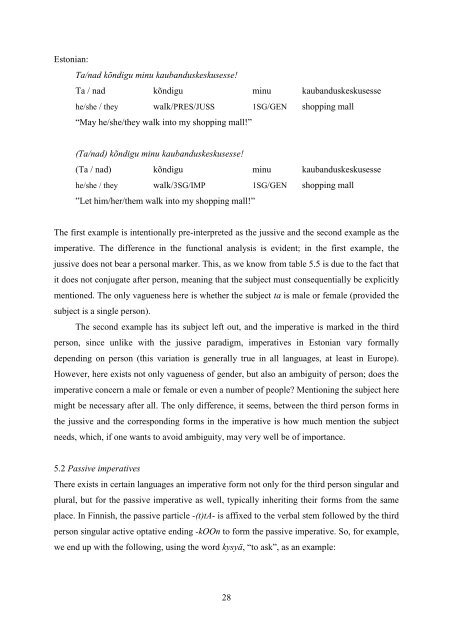The function of non-canonical imperatives in the languages of Europe
The function of non-canonical imperatives in the languages of Europe
The function of non-canonical imperatives in the languages of Europe
Create successful ePaper yourself
Turn your PDF publications into a flip-book with our unique Google optimized e-Paper software.
Estonian:<br />
Ta/nad kõndigu m<strong>in</strong>u kaubanduskeskusesse!<br />
Ta / nad kõndigu m<strong>in</strong>u kaubanduskeskusesse<br />
he/she / <strong>the</strong>y walk/PRES/JUSS 1SG/GEN shopp<strong>in</strong>g mall<br />
“May he/she/<strong>the</strong>y walk <strong>in</strong>to my shopp<strong>in</strong>g mall!”<br />
(Ta/nad) kõndigu m<strong>in</strong>u kaubanduskeskusesse!<br />
(Ta / nad) kõndigu m<strong>in</strong>u kaubanduskeskusesse<br />
he/she / <strong>the</strong>y walk/3SG/IMP 1SG/GEN shopp<strong>in</strong>g mall<br />
”Let him/her/<strong>the</strong>m walk <strong>in</strong>to my shopp<strong>in</strong>g mall!”<br />
<strong>The</strong> first example is <strong>in</strong>tentionally pre-<strong>in</strong>terpreted as <strong>the</strong> jussive and <strong>the</strong> second example as <strong>the</strong><br />
imperative. <strong>The</strong> difference <strong>in</strong> <strong>the</strong> <strong>function</strong>al analysis is evident; <strong>in</strong> <strong>the</strong> first example, <strong>the</strong><br />
jussive does not bear a personal marker. This, as we know from table 5.5 is due to <strong>the</strong> fact that<br />
it does not conjugate after person, mean<strong>in</strong>g that <strong>the</strong> subject must consequentially be explicitly<br />
mentioned. <strong>The</strong> only vagueness here is whe<strong>the</strong>r <strong>the</strong> subject ta is male or female (provided <strong>the</strong><br />
subject is a s<strong>in</strong>gle person).<br />
<strong>The</strong> second example has its subject left out, and <strong>the</strong> imperative is marked <strong>in</strong> <strong>the</strong> third<br />
person, s<strong>in</strong>ce unlike with <strong>the</strong> jussive paradigm, <strong>imperatives</strong> <strong>in</strong> Estonian vary formally<br />
depend<strong>in</strong>g on person (this variation is generally true <strong>in</strong> all <strong>languages</strong>, at least <strong>in</strong> <strong>Europe</strong>).<br />
However, here exists not only vagueness <strong>of</strong> gender, but also an ambiguity <strong>of</strong> person; does <strong>the</strong><br />
imperative concern a male or female or even a number <strong>of</strong> people Mention<strong>in</strong>g <strong>the</strong> subject here<br />
might be necessary after all. <strong>The</strong> only difference, it seems, between <strong>the</strong> third person forms <strong>in</strong><br />
<strong>the</strong> jussive and <strong>the</strong> correspond<strong>in</strong>g forms <strong>in</strong> <strong>the</strong> imperative is how much mention <strong>the</strong> subject<br />
needs, which, if one wants to avoid ambiguity, may very well be <strong>of</strong> importance.<br />
5.2 Passive <strong>imperatives</strong><br />
<strong>The</strong>re exists <strong>in</strong> certa<strong>in</strong> <strong>languages</strong> an imperative form not only for <strong>the</strong> third person s<strong>in</strong>gular and<br />
plural, but for <strong>the</strong> passive imperative as well, typically <strong>in</strong>herit<strong>in</strong>g <strong>the</strong>ir forms from <strong>the</strong> same<br />
place. In F<strong>in</strong>nish, <strong>the</strong> passive particle -(t)tA- is affixed to <strong>the</strong> verbal stem followed by <strong>the</strong> third<br />
person s<strong>in</strong>gular active optative end<strong>in</strong>g -kOOn to form <strong>the</strong> passive imperative. So, for example,<br />
we end up with <strong>the</strong> follow<strong>in</strong>g, us<strong>in</strong>g <strong>the</strong> word kysyä, “to ask”, as an example:<br />
28
















